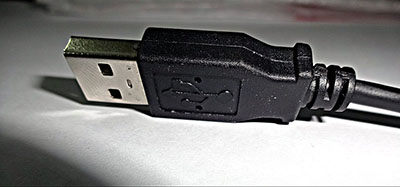USB History
A group of seven companies began the development of USB in 1994: Compaq, DEC, IBM, Intel,Microsoft, NEC, and Nortel. The goal was to make it fundamentally easier to connect external devices to PCs by replacing the multitude of connectors at the back of PCs, addressing the usability issues of existing interfaces, and simplifying software configuration of all devices connected to USB, as well as permitting greater data rates for external devices. A team includingAjay Bhatt worked on the standard at Intel; the first integrated circuits supporting USB were produced by Intel in 1995.
The original USB 1.0 specification, which was introduced in January 1996, defined data transfer rates of 1.5 Mbit/s "Low Speed" and 12 Mbit/s "Full Speed".The first widely used version of USB was 1.1, which was released in September 1998. The 12 Mbit/s data rate was intended for higher-speed devices such as disk drives, and the lower 1.5 Mbit/s rate for low data rate devices such as joysticks.
The USB 2.0 specification was released in April 2000 and was ratified by the USB Implementers Forum (USB-IF) at the end of 2001.Hewlett-Packard, Intel, Lucent Technologies (now Alcatel-Lucent), NEC and Philips jointly led the initiative to develop a higher data transfer rate, with the resulting specification achieving 480 Mbit/s, a 40-times increase over the original USB 1.1 specification.
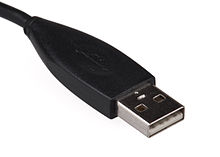 |
A USB Standard Type A plug, the most common USB plug
The USB 3.0 specification was published on 12 November 2008. Its main goals were to increase the data transfer rate (up to 5 Gbit/s), decrease power consumption, increase power output, and be backwards-compatible with USB 2.0. USB 3.0 includes a new, higher speed bus called SuperSpeed in parallel with the USB 2.0 bus. For this reason, the new version is also called SuperSpeed.The first USB 3.0 equipped devices were presented in January 2010.
As of 2008, approximately six billion USB ports and interfaces were in the global marketplace, and about two billion were being sold each year.
Version history
Prereleases
A PCI USB 2.0 card for a computer motherboard
Prereleases
The USB standard evolved through several versions before its official release in 1996:
• USB 0.7 – released in November 1994
• USB 0.8 – released in December 1994
• USB 0.9 – released in April 1995
• USB 0.99 – released in August 1995
• USB 1.0 Release Candidate – released in November 1995
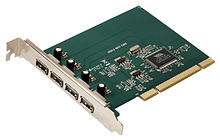 |
A PCI USB 2.0 card for a computer motherboard
USB 1.x
Released in January 1996, USB 1.0 specified data rates of 1.5 Mbit/s (Low-Bandwidth) and 12 Mbit/s (Full-Bandwidth). It did not allow for extension cables or pass-through monitors, due to timing and power limitations. Few USB devices made it to the market until USB 1.1 was released in August 1998, fixing problems identified in 1.0, mostly related to using hubs. USB 1.1 was the earliest revision that was widely adopted.
USB 2.0
The Hi-Speed USB Logo
USB 2.0 was released in April 2000 (now called "Hi-Speed"), adding higher maximum signaling rate of 480 Mbit/s (due to bus access constraints the effective throughput is limited to 35 MB/s or 280 Mbit/s), in addition to the "USB 1.x Full Speed" signaling rate of 12 Mbit/s.
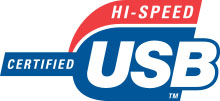 |
A PCI USB 2.0 card for a computer motherboard
Further modifications to the USB specification have been done via Engineering Change Notices (ECN). The most important of these ECNs are included into the USB 2.0 specification package available from USB.org:
• Mini-A and Mini-B Connector ECN: Released in October 2000.
Specifications for Mini-A and B plug and receptacle. Also receptacle that accepts both plugs for On-The-Go. These should not be confused with Micro-B plug and receptacle.
• Errata as of December 2000: Released in December 2000
• Pull-up/Pull-down Resistors ECN: Released in May 2002
• Errata as of May 2002: Released in May 2002
Interface Associations ECN: Released in May 2003.
New standard descriptor was added that allows associating multiple interfaces with a single device function.
• Rounded Chamfer ECN: Released in October 2003.
A recommended, compatible change to Mini-B plugs that results in longer lasting connectors.
• Unicode ECN: Released in February 2005.
This ECN specifies that strings are encoded using UTF-16LE. USB 2.0 specified Unicode, but did not specify the encoding.
• Inter-Chip USB Supplement: Released in March 2006
• On-The-Go Supplement 1.3: Released in December 2006.
USB On-The-Go makes it possible for two USB devices to communicate with each other without requiring a separate USB host. In practice, one of the USB devices acts as a host for the other device.
• Battery Charging Specification 1.1: Released in March 2007 (Updated 15 Apr 2009).
Adds support for dedicated chargers (power supplies with USB connectors), host chargers (USB hosts that can act as chargers) and the No Dead Battery provision, which allows devices to temporarily draw 100 mA current after they have been attached. If a USB device is connected to dedicated charger, maximum current drawn by the device may be as high as 1.8 A. (Note that this document is not distributed with USB 2.0 specification package only USB 3.0 and USB On-The-Go.)
• Micro-USB Cables and Connectors Specification 1.01: Released in April 2007.
• Link Power Management Addendum ECN: Released in July 2007.
This adds "sleep", a new power state between enabled and suspended states. Device in this state is not required to reduce its power consumption. However, switching between enabled and sleep states is much faster than switching between enabled and suspended states, which allows devices to sleep while idle.
• Battery Charging Specification 1.2: [20] Released in December 2010.
Several changes and increasing limits including allowing 1.5 A on charging ports for unconfigured devices, allowing High Speed communication while having a current up to 1.5 A and allowing a maximum current of 5 A.
USB 3.0
Main article: USB 3.0
USB 3.0 was released in November 2008. The standard defines a new SuperSpeed mode with a signaling speed of 5 Gbit/s and, due to encoding overhead, usable data rate of up to 4 Gbit/s (500 MB/s). A USB 3.0 port is usually colored blue, and is backwards compatible with USB 2.0.
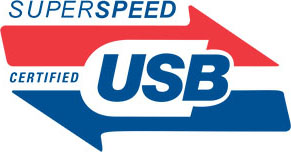 |
The SuperSpeed USB Logo
The USB 3.0 Promoter Group announced on 17 November 2008 that the specification of version 3.0 had been completed and had made the transition to the USB Implementers Forum (USB-IF), the managing body of USB specifications.This move effectively opened the specification to hardware developers for implementation in products.
The new SuperSpeed bus provides a fourth transfer mode at 5.0 Gbit/s (raw data rate), in addition to the modes supported by earlier versions. The payload throughput is 4 Gbit/s (using 8b/10b encoding), and the specification considers it reasonable to achieve around 3.2 Gbit/s (0.4 GB/s or 400 MB/s), which should increase with future hardware advances. Communication is full-duplex in SuperSpeed transfer mode; in the modes supported previously, by 1.x and 2.0, communication is half-duplex, with direction controlled by the host.
As with previous USB versions, USB 3.0 ports come in low-power and high-power variants, providing 150 mA and 900 mA respectively while simultaneously transmitting data at SuperSpeed rates. Additionally, there is a Battery Charging Specification (Version 1.2 – December 2010), which increases the power handling capability to 1.5 A but does notallow concurrent data transmission. The Battery Charging Specification requires that the physical ports themselves be capable of handling 5 A of current[citation needed] but the specification limits the maximum current drawn to 1.5 A.
USB 3.1
A January 2013 press release from the USB group revealed plans to update USB 3.0 to 10 Gbit/s, effectively putting it on par with Thunderbolt by mid-2013.The USB 3.1 specification was released on 31 July 2013,introducing a faster transfer mode called "SuperSpeed USB 10 Gbps"; its logo features a Superspeed+ (stylized asSUPERSPEED+) caption. The USB 3.1 standard increases the signalling rate to 10 Gbit/s, double that of USB 3.0, and reduces line encoding overhead to just 3% by changing the encoding scheme to 128b/132b.Though, some initial tests demonstrated usable transfer speeds of only 7.2 Gbit/s, leading to a 30% overall overhead.
The USB 3.1 standard is backward compatible with USB 3.0 and USB 2.0. Using three power profiles of those defined in the USB Power Delivery Specification, it lets devices with larger energy demands request higher currents and supply voltages from compliant hosts – up to 2 A at 5 V (for a power consumption of up to 10 W), and optionally up to 5 A at either 12 V (60 W) or 20 V (100 W).
